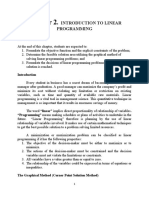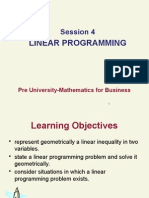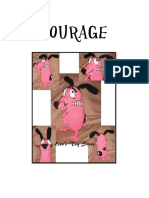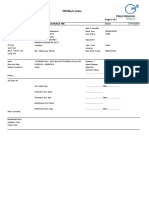0 ratings0% found this document useful (0 votes)
20 viewsGraphical Method of Solving LPP
The document discusses using the graphical method to solve linear programming problems. It provides steps for using the graphical method, including identifying the problem, drawing the feasible region from the constraints, finding the optimal solution that maximizes the objective function, and interpreting the results. It then provides an example problem about maximizing profit from producing two TV models with constraints on labor hours and machine time.
Uploaded by
HailemariamCopyright
© © All Rights Reserved
Available Formats
Download as PPTX, PDF, TXT or read online on Scribd
0 ratings0% found this document useful (0 votes)
20 viewsGraphical Method of Solving LPP
The document discusses using the graphical method to solve linear programming problems. It provides steps for using the graphical method, including identifying the problem, drawing the feasible region from the constraints, finding the optimal solution that maximizes the objective function, and interpreting the results. It then provides an example problem about maximizing profit from producing two TV models with constraints on labor hours and machine time.
Uploaded by
HailemariamCopyright
© © All Rights Reserved
Available Formats
Download as PPTX, PDF, TXT or read online on Scribd
You are on page 1/ 25
Graphical Method of solving LPP
• To use the graphic method, the following steps are
needed:
1. Identify the problem – determine the decision
variables, the objective function, and the constraints.
2. Draw a graph including all the constraints and
identify the feasible region.
3. Obtain a point on the feasible region that optimizes
the objective function – optimal solution.
4. Interpret the results.
Note: Graphical LP is a two-dimensional model.
The Maximization Problem
• This is the case of Maximize Z with inequalities of constraints
in form.
• Consider two models of color TV sets; Model A and B, are
produced by a company to maximize profit. The profit realized
is $300 from A and $250 from set B. The limitations are
a) Availability of only 40 hrs of labor each day in the production
department,
b) A daily availability of only 45 hrs on machine time, and
c) Ability to sale 12 set of model A.
• How many sets of each model will be produced each day so
that the total profit will be as large as possible?
7. Interpret the result. Accordingly, the
highlighted result in the table above
implies that 12 units of Model A and
11 units of Model B TV sets should be
produced so that the total profit will
be $6350.
• Example 3.4 : A manufacturer of Light Weight mountain tents
makes two types of tents:
• REGULAR tent and SUPER tent.
• Each REGULAR tent requires one labor-hour from the cutting
department and 3 labor-hours from the assembly department.
• Each SUPER tent requires 2 labor-hours from the cutting
department and 4 labor-hours from the assembly department.
• The maximum labor hours available per week in the cutting
department and the assembly department are 32 and 84
respectively.
• Moreover, the distributor, because of demand, will not take
more than 12 SUPER tents per week.
• The manufacturer sales each REGULAR tents for $160 and
costs $110 per tent to make. Where as SUPER tent ales for
$210 per tent and costs $130 per tent to make.
Required
a) Formulate the mathematical model of the
problem
b) Using the graphic method, determine how many
of each tent the company should manufacture
each week so as to maximize its profit?
c) What is this maximum profit assuming that all
the tents manufactured in each week are sold in
that week
• The distributor will not take more than 12
SUPER tents per week. Thus, the
manufacturer should not produce more than
12 SUPER tents per week.
• Dear student, please formulate the
mathematical model based on the
information in the above table before going to
the solution part.
3. The Interpretation:
• The manufacturer should produce and sale 20
REGULAR tents and 6 SUPERS tents to get a
maximum weekly profit of $1480.
• Dear student, try to solve the above example by
adding 5 to each coefficient and 10 to the right
hand side values of the constraints.
The Minimization Problem
• In this case, we deal with Minimize Z with inequalities of
constraints in form
• Example 3.4 :Suppose that a machine shop has two
different types of machines; Machine 1 and Machine 2,
which can be used to make a single product.
• These machines vary in the amount of product produced
per hr., in the amount of labor used and in the cost of
operation.
• Assume that at least a certain amount of product must be
produced and that we would like to utilize at least the
regular labor force.
• How much should we utilize on each machine in order to
utilize total costs and still meets the requirement?
• Note:
• In maximization problems, our point of
interest is looking the furthest point from the
origin (Maximum value of Z).
• In minimization problems, our point of
interest is looking the point nearest to the
origin (Minimum value of Z).
You might also like
- Ebooks File Cambridge Essential English Dictionary 2nd Edition Cambridge University Press All Chapters100% (3)Ebooks File Cambridge Essential English Dictionary 2nd Edition Cambridge University Press All Chapters78 pages
- Advanced Quantitative Analysis For Managerial DecisionNo ratings yetAdvanced Quantitative Analysis For Managerial Decision96 pages
- Ch-2 Linear Programming 2-1 Introduction To Linear ProgrammingNo ratings yetCh-2 Linear Programming 2-1 Introduction To Linear Programming11 pages
- Introduction, Modeling, Graphical MethodNo ratings yetIntroduction, Modeling, Graphical Method56 pages
- Master of Business Administration: Quantitative Analysis For Management DecisionsNo ratings yetMaster of Business Administration: Quantitative Analysis For Management Decisions75 pages
- LLP - Graphical Method-Kanti Swarup PDFNo ratings yetLLP - Graphical Method-Kanti Swarup PDF18 pages
- Linear Programming: Model Formulation and Graphical SolutionNo ratings yetLinear Programming: Model Formulation and Graphical Solution65 pages
- Quantitative Techniques: LPP - Graphical MethodNo ratings yetQuantitative Techniques: LPP - Graphical Method39 pages
- DAM HO PTMBA LPP Graphical With SolutionsNo ratings yetDAM HO PTMBA LPP Graphical With Solutions24 pages
- Mekelle University College of Business and Economics Department of ManagementNo ratings yetMekelle University College of Business and Economics Department of Management29 pages
- W23L_Linear Programming Using Graphical MethodNo ratings yetW23L_Linear Programming Using Graphical Method35 pages
- 04 Examples & Cases On LP Model Formulation-1No ratings yet04 Examples & Cases On LP Model Formulation-17 pages
- CH 2 Operation Strategy and CompetitivenessNo ratings yetCH 2 Operation Strategy and Competitiveness52 pages
- Chapter 3 Part II Process Selection and Facility LayoutNo ratings yetChapter 3 Part II Process Selection and Facility Layout46 pages
- CH 3 Part 3 Faility Location and Layout OwnNo ratings yetCH 3 Part 3 Faility Location and Layout Own106 pages
- Chapter Two Matrices and Application of MatricesNo ratings yetChapter Two Matrices and Application of Matrices44 pages
- Mental Models: An Interdisciplinary Synthesis of Theory and MethodsNo ratings yetMental Models: An Interdisciplinary Synthesis of Theory and Methods13 pages
- Angel - 2003 - Teaching Susan Glaspell's A Jury of Her Peers and TriflesNo ratings yetAngel - 2003 - Teaching Susan Glaspell's A Jury of Her Peers and Trifles17 pages
- Theology and The Curriculum: Univer1Jit11, Is Still Seen As A Major Philosophical Statement On The NaNo ratings yetTheology and The Curriculum: Univer1Jit11, Is Still Seen As A Major Philosophical Statement On The Na11 pages
- AT Attachment With Packet Interface - 7 Volume 1No ratings yetAT Attachment With Packet Interface - 7 Volume 1390 pages
- PCB (Printed Circuit Board) Layout and EMI (Electromagnetic I..100% (3)PCB (Printed Circuit Board) Layout and EMI (Electromagnetic I..2 pages
- Target constants for Leica Total StationNo ratings yetTarget constants for Leica Total Station4 pages
- Peace Corps OST Focus In/Train Up (FITU) Focus in - Train Up Action PlanNo ratings yetPeace Corps OST Focus In/Train Up (FITU) Focus in - Train Up Action Plan2 pages
- ALGEBRAIC EXPRESSIONS Term 2 Lesson 7 Grade 8No ratings yetALGEBRAIC EXPRESSIONS Term 2 Lesson 7 Grade 85 pages
- Physical Education and Health 12: 3 Quarter Week 3No ratings yetPhysical Education and Health 12: 3 Quarter Week 36 pages
- Montague Blacksmith Supply 2009 CatalogNo ratings yetMontague Blacksmith Supply 2009 Catalog46 pages
- Ch-2&3; particle and fiber board ppt (2)No ratings yetCh-2&3; particle and fiber board ppt (2)19 pages
- Ebooks File Cambridge Essential English Dictionary 2nd Edition Cambridge University Press All ChaptersEbooks File Cambridge Essential English Dictionary 2nd Edition Cambridge University Press All Chapters
- Advanced Quantitative Analysis For Managerial DecisionAdvanced Quantitative Analysis For Managerial Decision
- Ch-2 Linear Programming 2-1 Introduction To Linear ProgrammingCh-2 Linear Programming 2-1 Introduction To Linear Programming
- Master of Business Administration: Quantitative Analysis For Management DecisionsMaster of Business Administration: Quantitative Analysis For Management Decisions
- Linear Programming: Model Formulation and Graphical SolutionLinear Programming: Model Formulation and Graphical Solution
- Mekelle University College of Business and Economics Department of ManagementMekelle University College of Business and Economics Department of Management
- Practice Problems in Statistics and Data ReductionFrom EverandPractice Problems in Statistics and Data Reduction
- Chapter 3 Part II Process Selection and Facility LayoutChapter 3 Part II Process Selection and Facility Layout
- Mental Models: An Interdisciplinary Synthesis of Theory and MethodsMental Models: An Interdisciplinary Synthesis of Theory and Methods
- Angel - 2003 - Teaching Susan Glaspell's A Jury of Her Peers and TriflesAngel - 2003 - Teaching Susan Glaspell's A Jury of Her Peers and Trifles
- Theology and The Curriculum: Univer1Jit11, Is Still Seen As A Major Philosophical Statement On The NaTheology and The Curriculum: Univer1Jit11, Is Still Seen As A Major Philosophical Statement On The Na
- PCB (Printed Circuit Board) Layout and EMI (Electromagnetic I..PCB (Printed Circuit Board) Layout and EMI (Electromagnetic I..
- Peace Corps OST Focus In/Train Up (FITU) Focus in - Train Up Action PlanPeace Corps OST Focus In/Train Up (FITU) Focus in - Train Up Action Plan
- Physical Education and Health 12: 3 Quarter Week 3Physical Education and Health 12: 3 Quarter Week 3


































































































